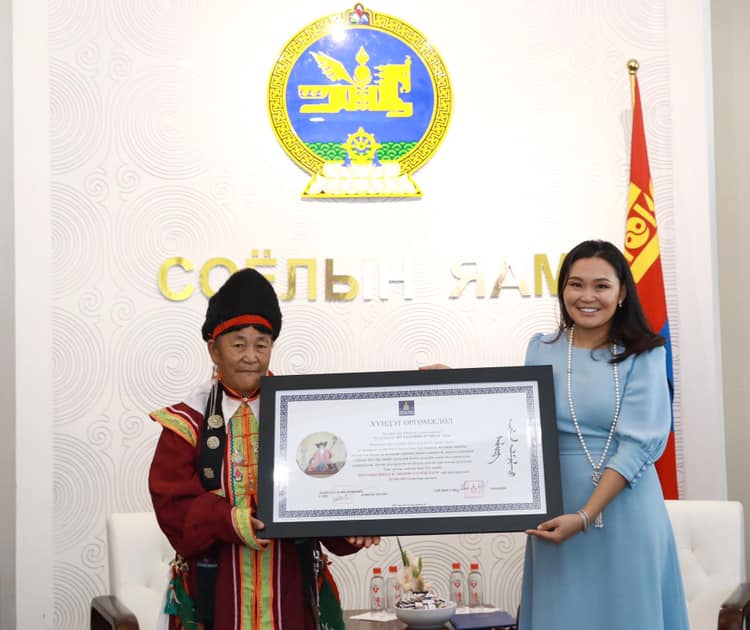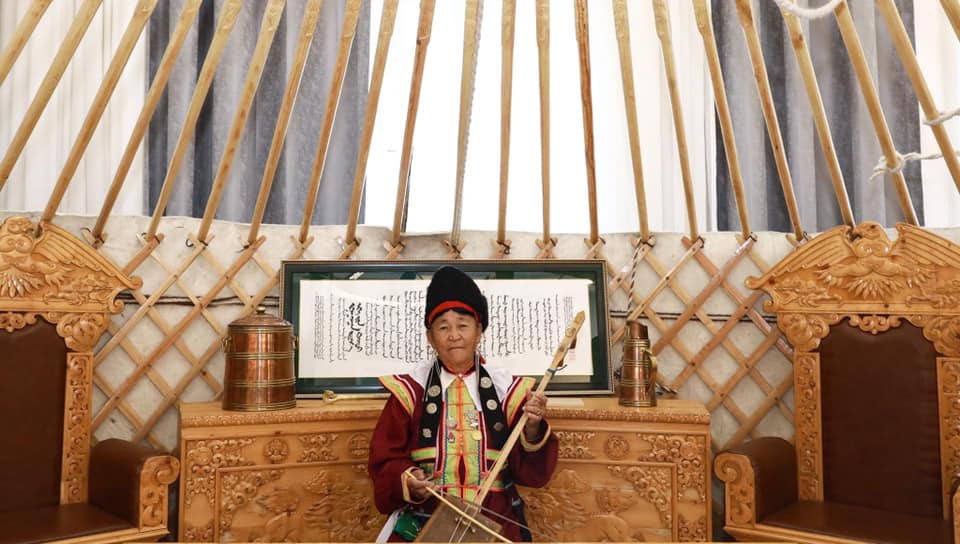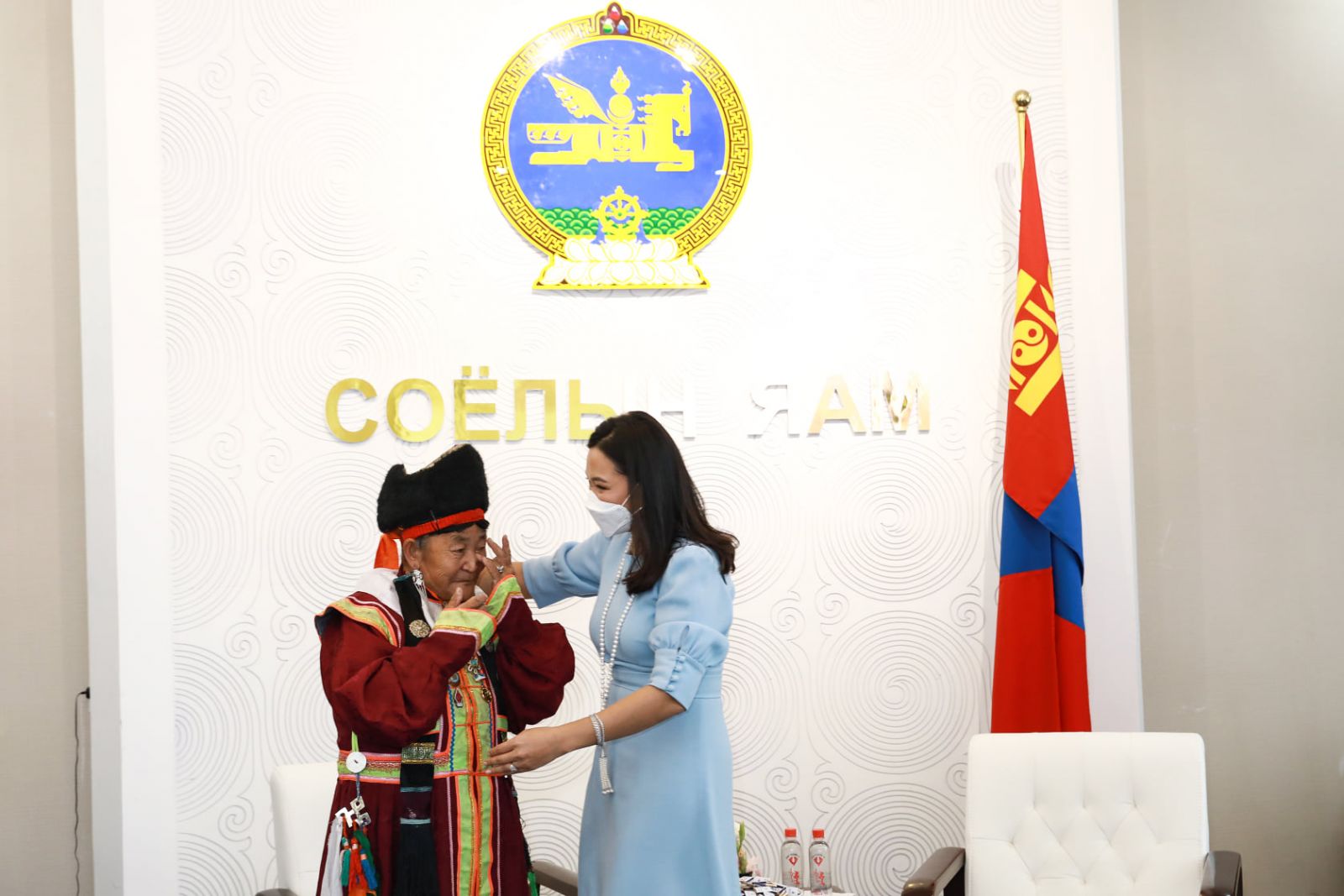J. KHUMBAA, THE BEST INHERITANT HERITAGE: HAPPY BIRTHDAY TO 3.3 MILLION PEOPLE

J.Khumbaa is a talented person who has dedicated about 70 years of his conscious life to teaching and disseminating to the next generation. At the age of 10, he was taught to play the piano by his parents. Since 1959, he has been working in the soum as a cooperative herder, school cook, hospital nurse, and hotel attendant for more than 30 years and has retired.

Also, “Altan Tulga” Folk Art Festival held in Ulaanbaatar, 1st and 2nd National Exhibition of Folk Art, International Film Festival, Folk Art Festival organized on the occasion of the 80th anniversary of the People's Revolution, UNESCO's Mongolian Morin Khuur Traditional Music Participated in national and international festivals such as “Oirat Tumen” Naadam and “Nomadic Mongolia 2018” cultural festival, won gold medals, gold, silver and bronze medals He was awarded the “Inheritor”, the “Best Inheritor” medal of Mongolia, and the “Honorary Award” of UNESCO. He toured China in 1990 and Tuva, Russia in 2002.
He starred with his students in documentaries such as "Tsatsal", "Voice of Ikhel Khuur", Mongolian-French joint "Morin Khuur" and "Bayad's Wedding Ceremony". The soundtrack of the Ikh Khuur was nominated for an Oscar. In recognition of his hard work, efforts and merits in inheriting and disseminating the traditional heritage of the Mongolian people, performing arts and music, and passing it on to the younger generation, in 2012 he was awarded the “National List of Mongolian Talents who inherited intangible cultural heritage at a high level of skill”. Registered in and approved. In 2007, he was awarded the “Leading Cultural Worker of Mongolia” badge, and in 2008, he was awarded the “Altan Gadas” medal, the highest state award.
He was named the third best inheritor of Mongolia's intangible cultural heritage and was awarded an honorary title and 30 million MNT. During this time, he shared his impressions of the holiday and talked.
- Congratulations on being selected as the best intangible heritage inheritor. When you have worked hard for others for many years?
-I appreciated and encouraged the little knowledge I learned from my parents. From the age of 10 to the age of 80, I sang and played the Ikhel, Morin Khuur, and Biy in all its forms. In the past, I have tried to teach my knowledge to my children, future generations, and anyone who wants to learn and know. I am grateful that he is valued, rewarded and rewarded by the state, and that 3.3 million Mongolians are blessed.
-Do you live in your soum?
-I live in the center of Malchin soum of Uvs aimag. I have eight children. There are more than 70 people, including grandchildren and great-grandchildren. My husband became a god at the age of 61. Since then, my children have taken turns taking care of me.
-It is said that you teach lessons at home, contributing to the legacy of wealth and fulfillment. How many disciples did you have?
-In collaboration with Parchin Center of Ulaangom soum, “Uran Manlai” Center of Root Arts of Western Mongolia, Khyargas and Malchin soum cultural centers, Bayad created a performance and folk music circle. In the last two years, my legs have deteriorated, I have less time to go out, and I have more than 500 students. There are times when it is sunny and warm to teach outside. The head of the soum club provides me with a fiddle and clothes to teach me how to play the fiddle. In recent years, we have been talking about the dissemination and protection of intangible cultural heritage across the country, and I am very happy that we are working in this direction. I think I have made many disciples because of their virtue. This year, due to the plague, four children were taught the fiddle.
-Is it difficult to learn the piano?
-It is very difficult to learn the accordion. It takes many days of preparation to get the right music and the right body. Inheritors play eight melodies on the flute. It takes a long time to teach old songs, blessings, and praises. When children learn a lot of music, they are encouraged to teach each other. At one time, I prepared for an event or celebration for three or four days and then took part in a concert. Out of 63 people who were taught to play the fiddle, one man and one woman were selected to participate in the national festival in Ulaanbaatar.
-Are any of your students well-known?
-Body performers are being born in Khyargas soum. Some of my students work as fiddle teachers in Khyargas soum. Recently, not only soum residents but also people from other soums have come to study.
-You learned the fiddle from your parents. Were they very talented?
-I have six from my parents. My mother and sister played the fiddle very well. I learned to play the accordion from them. It was worse than my parents. But I was attracted to my size.
-Did your childhood memories have anything to do with playing the piano?

-Of course. I learned to see and imitate everything from my parents. They were the teachers of my life. Modern children are learning a variety of things. I play a lot with my cell phone next to it. I worry about that a lot. I went to school at the age of nine and dropped out in sixth grade. When I was in school, I loved participating in art events. When I went to school, I learned the poem “Choibalsan as a child” and I still remember it. Sometimes I read. I learned to play the iron, bamboo fiddle, horse fiddle, and big music, and I still teach others. As I got older, I couldn't stand the music and my hands hurt.
-Do you teach for a fee?
- No, it's not. We want our children to spend their free time wisely and to learn new things.
-What do you think will be done in the future to disseminate, preserve and preserve the intangible cultural heritage?
-I will teach my music at home until the end. As I get older, I don't think I can do more than that.
Source:Ergelt.mn
J.Khumbaa is a talented person who has dedicated about 70 years of his conscious life to teaching and disseminating to the next generation. At the age of 10, he was taught to play the piano by his parents. Since 1959, he has been working in the soum as a cooperative herder, school cook, hospital nurse, and hotel attendant for more than 30 years and has retired.

Also, “Altan Tulga” Folk Art Festival held in Ulaanbaatar, 1st and 2nd National Exhibition of Folk Art, International Film Festival, Folk Art Festival organized on the occasion of the 80th anniversary of the People's Revolution, UNESCO's Mongolian Morin Khuur Traditional Music Participated in national and international festivals such as “Oirat Tumen” Naadam and “Nomadic Mongolia 2018” cultural festival, won gold medals, gold, silver and bronze medals He was awarded the “Inheritor”, the “Best Inheritor” medal of Mongolia, and the “Honorary Award” of UNESCO. He toured China in 1990 and Tuva, Russia in 2002.
He starred with his students in documentaries such as "Tsatsal", "Voice of Ikhel Khuur", Mongolian-French joint "Morin Khuur" and "Bayad's Wedding Ceremony". The soundtrack of the Ikh Khuur was nominated for an Oscar. In recognition of his hard work, efforts and merits in inheriting and disseminating the traditional heritage of the Mongolian people, performing arts and music, and passing it on to the younger generation, in 2012 he was awarded the “National List of Mongolian Talents who inherited intangible cultural heritage at a high level of skill”. Registered in and approved. In 2007, he was awarded the “Leading Cultural Worker of Mongolia” badge, and in 2008, he was awarded the “Altan Gadas” medal, the highest state award.
He was named the third best inheritor of Mongolia's intangible cultural heritage and was awarded an honorary title and 30 million MNT. During this time, he shared his impressions of the holiday and talked.
- Congratulations on being selected as the best intangible heritage inheritor. When you have worked hard for others for many years?
-I appreciated and encouraged the little knowledge I learned from my parents. From the age of 10 to the age of 80, I sang and played the Ikhel, Morin Khuur, and Biy in all its forms. In the past, I have tried to teach my knowledge to my children, future generations, and anyone who wants to learn and know. I am grateful that he is valued, rewarded and rewarded by the state, and that 3.3 million Mongolians are blessed.
-Do you live in your soum?
-I live in the center of Malchin soum of Uvs aimag. I have eight children. There are more than 70 people, including grandchildren and great-grandchildren. My husband became a god at the age of 61. Since then, my children have taken turns taking care of me.
-It is said that you teach lessons at home, contributing to the legacy of wealth and fulfillment. How many disciples did you have?
-In collaboration with Parchin Center of Ulaangom soum, “Uran Manlai” Center of Root Arts of Western Mongolia, Khyargas and Malchin soum cultural centers, Bayad created a performance and folk music circle. In the last two years, my legs have deteriorated, I have less time to go out, and I have more than 500 students. There are times when it is sunny and warm to teach outside. The head of the soum club provides me with a fiddle and clothes to teach me how to play the fiddle. In recent years, we have been talking about the dissemination and protection of intangible cultural heritage across the country, and I am very happy that we are working in this direction. I think I have made many disciples because of their virtue. This year, due to the plague, four children were taught the fiddle.
-Is it difficult to learn the piano?
-It is very difficult to learn the accordion. It takes many days of preparation to get the right music and the right body. Inheritors play eight melodies on the flute. It takes a long time to teach old songs, blessings, and praises. When children learn a lot of music, they are encouraged to teach each other. At one time, I prepared for an event or celebration for three or four days and then took part in a concert. Out of 63 people who were taught to play the fiddle, one man and one woman were selected to participate in the national festival in Ulaanbaatar.
-Are any of your students well-known?
-Body performers are being born in Khyargas soum. Some of my students work as fiddle teachers in Khyargas soum. Recently, not only soum residents but also people from other soums have come to study.
-You learned the fiddle from your parents. Were they very talented?
-I have six from my parents. My mother and sister played the fiddle very well. I learned to play the accordion from them. It was worse than my parents. But I was attracted to my size.
-Did your childhood memories have anything to do with playing the piano?

-Of course. I learned to see and imitate everything from my parents. They were the teachers of my life. Modern children are learning a variety of things. I play a lot with my cell phone next to it. I worry about that a lot. I went to school at the age of nine and dropped out in sixth grade. When I was in school, I loved participating in art events. When I went to school, I learned the poem “Choibalsan as a child” and I still remember it. Sometimes I read. I learned to play the iron, bamboo fiddle, horse fiddle, and big music, and I still teach others. As I got older, I couldn't stand the music and my hands hurt.
-Do you teach for a fee?
- No, it's not. We want our children to spend their free time wisely and to learn new things.
-What do you think will be done in the future to disseminate, preserve and preserve the intangible cultural heritage?
-I will teach my music at home until the end. As I get older, I don't think I can do more than that.
Source:Ergelt.mn